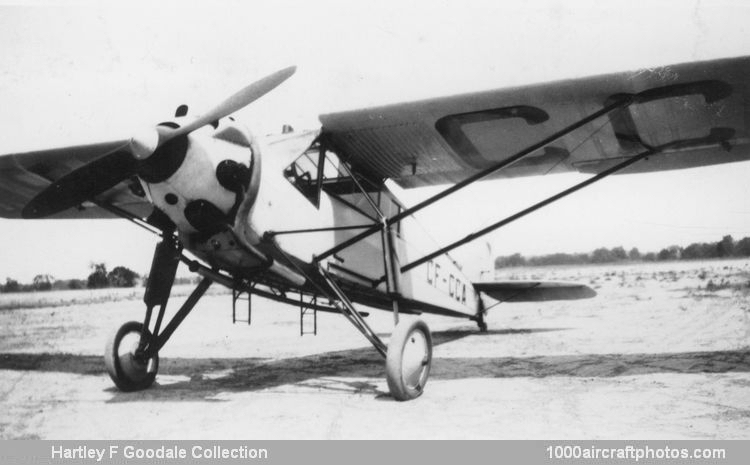11/15/2020. Remarks by Johan Visschedijk: "The D.H.75 Hawk Moth was a four seat cabin monoplane which had been designed for light transport or taxi work overseas.
Fabric covered, composite construction that had proved so ruggedly serviceable under extremes of temperature in the D.H.66 was again used for the Hawk Moth, which combined a welded steel fuselage and tail unit with a wooden wing. The roomy cabin had two paired seats for pilot and three passengers with provision for dual control and luggage space in the rear. It was fitted as usual with generous Triplex sliding windows and each pair of seats had its own door, but only on the starboard side. Fuel tanks of 35 gallons capacity were housed in the wing roots, the mainplane being built in two halves and shoulder mounted. It was braced by two streamlined tubular steel struts, the front one also forming part of the pyramid structure of the landing gear from which it could be released by a spring loaded pin for wing folding. Power plant was the new 198 hp de Havilland Ghost eight-cylinder air-cooled V-engine.
de Havilland's test pilot Hubert Stanford Broad flew the prototype for the first time at Stag Lane, London, on December 7, 1928 but it was underpowered and the performance was disappointing. Several more Hawk Moths were then built with mainplanes of increased span and 16 in (41 cm) greater chord. The first two had 240 hp Armstrong Siddeley Lynx seven-cylinder air-cooled geared radial engines which gave them a much more useful performance. At this stage the type was known for a short time as the Moth Six in order to emphasize its relationship to its smaller brother the Puss Moth then coming on the market with the short-lived name Moth Three.
Designated D.H.75A, the first two Lynx powered machines had a considerable history. One was exhibited with a wing folded, but without markings, at the Olympia Aero Show of 1929 after which the first one, G-AAFW, was demonstrated in Canada in December 1929 and afterwards flown extensively by P.C. Garrett of de Havilland Aircraft of Canada Ltd. (DHC). Trials with this machine on skis and with the sister aircraft G-AAFX on Short floats at Rochester in the UK, led in 1930 to Contract 1907 for three Lynx engined Hawk Moths with interchangeable landing gears for the Canadian Government.
First of these (former G-AAFW) was based at Ottawa for personal use by the Controller of Civil Aviation, temporarily reregistered CF-CCA in November 1929, but having no doors on the port side, was not permitted to fly as a seaplane. Subsequently it was registered to the RCAF as G-CYVD on December 4, 1929. It was struck off charge at Camp Borden on October 8, 1935.
The others, G-CYVL and G-CYVM, intended for Government civil operations, had doors on both sides and Hamilton adjustable pitch metal airscrews as well as strengthened wing root fittings and cabin roof structures. They were cleared for float operation after tests at Rockcliffe by DHC test pilot Leigh Capreol on October 4, 1930 but payload was very limited and the aircraft flew thereafter only on wheels or skis. Several landing gear failures occurred and after G-CYVL crashed during acceptance tests as a landplane at Longueil, Quebec in 1931, the others were flown only with prior permission until withdrawn from use a year or so later and converted into snowmobiles at Camp Borden.
Australian markets were also aimed at and G-AAFX went to de Havilland Aircraft of Australia Pty. Ltd. (DHA) at Bankstown Aerodrome, New South Wales, as demonstrator in 1930. On June 3 of that year Amy Johnson flew in it from Brisbane to Sydney after her D.H.60 Gipsy Moth G-AAAH "Jason" had come to grief. Hart Aircraft Services of Melbourne used it on charter until Tasmanian Airways bought it in February 1934 but after serious damage in a forced landing at Brighton, Tasmania on January 10, 1935, it was rebuilt with a 300 hp Wright Whirlwind J-5 nine-cylinder air-cooled radial engine. It then flew with a series of owners until January 1943 when a 350 hp Armstrong Siddeley Cheetah IX seven-cylinder air-cooled radial engine was fitted by the final operator, Connellan Airways Ltd., Alice Springs.
Competition from American types such as the Ryan B-1 Brougham, killed the Hawk Moth within a year. In an unsuccessful attempt to recapture the market, one machine, designated D.H.75B, was fitted in March 1929 with 300 hp Wright Whirlwind R-975, power plant of the Ryans which were filtering into Canada, Australia and even England.
Total Hawk Moth production was eight, one of which, VH-UOY, was flown by Ron Adair, proprietor of DHA, on daily services to Toowoomba, Maryborough and in 1931 to the goldmining center of Cracow. The fifth production aircraft G-AAUZ, certificated in June 1930, was H.R.H. Prince George's entry for the King's Cup race in which it came seventh, piloted from Han worth to Cramlington and back by Flight Lieutenant E.H. Fielden at an average speed of 126.2 mph (203.1 kmh) In 1932 G-AAUZ acquired the traditional red fuselage of Air Taxis Ltd., the charter firm which Captain W.L. Hope opened at Stag Lane when the de Havilland Hire Service closed down, and gave invaluable service until stored in June 1934 and sold abroad in December 1938.
